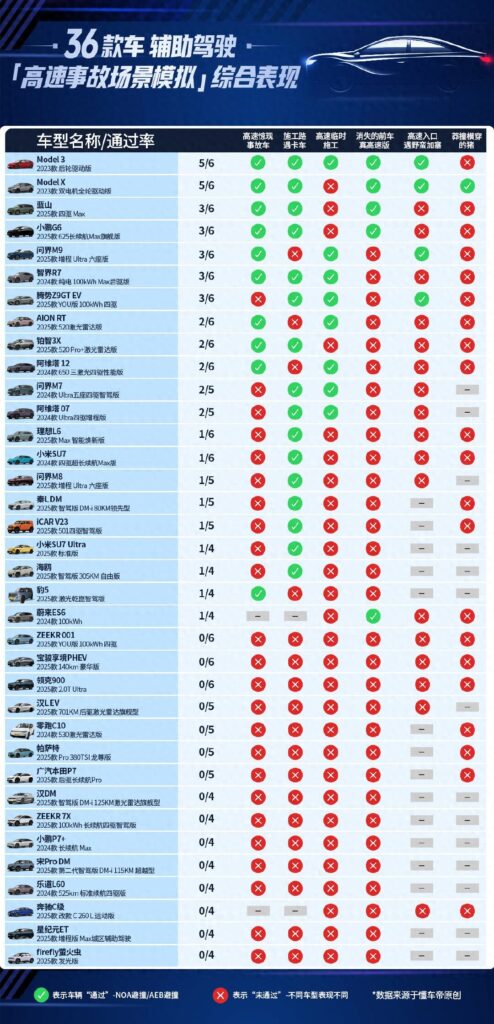Decoding the Dongchedi ADAS Test: A Detailed Look at the 36-Car Safety Results
The recent Advanced Driver-Assistance Systems (ADAS) test conducted by Chinese automotive platform Dongchedi has generated significant discussion globally. The centerpiece of this discussion is a comprehensive chart detailing the performance of 36 vehicles in simulated high-risk scenarios.
This page provides a clear breakdown of that chart, explaining the test scenarios and presenting the key results for context.

The Six Critical Scenarios Explained
The test was not about everyday driving comfort. It was a stress test designed to evaluate how a vehicle’s ADAS handles sudden, life-threatening situations on the highway. Each car was evaluated across six distinct scenarios:
- Sudden Accident Vehicle: Simulates encountering a stationary vehicle in a lane after cresting a hill or rounding a bend, a common cause of high-speed collisions.
- Construction Truck Encounter: Tests the system’s ability to identify and safely navigate around a large, slow-moving or stationary construction truck partially obstructing the lane.
- Temporary Highway Construction: Evaluates performance when navigating a makeshift construction zone with cones and temporary lane changes, testing object recognition and path planning.
- Disappearing Lead Vehicle (Ghost Cut-out): A crucial test where the car you are following abruptly swerves out of the lane, revealing a stationary obstacle directly ahead. This tests the system’s reaction time.
- Aggressive Highway Merge/Cut-in: A vehicle aggressively cuts into the lane from a highway on-ramp with little warning, testing the system’s predictive braking and avoidance capabilities.
- Sudden Animal Crossing (“The Pig Test”): Simulates a large animal (represented by a realistic dummy) suddenly running across the highway, a notoriously difficult scenario for many sensor systems to classify and react to in time.
Key Results and Observations
The chart ranks vehicles by their “Pass Rate,” or the number of scenarios they successfully navigated out of the total tested.
- Top Performers (5/6):
- Tesla Model 3 and Tesla Model X were the clear leaders, successfully passing five of the six critical tests, showcasing the robustness of their vision-only system in high-stakes situations.
- Second Tier (3/6):
- A distinct group of vehicles managed to pass half of the scenarios. This group includes models like the WEY Lanshan, XPeng G6, and Huawei-powered vehicles like the AITO M9 and Luxeed R7.
- Underperformers (1/6 or less):
- A surprisingly large number of popular and technologically advanced models scored very poorly. This includes the Xiaomi SU7 Max (1/6), NIO ES6 (1/4), and a significant number of vehicles from brands like BYD, ZEEKR, and Leapmotor which scored 0 on all applicable tests.
This data provides a sobering, factual look at the current state of ADAS technology. While many systems excel at providing convenience, their ability to handle unexpected, critical safety events varies dramatically.
For a full analysis of what these results mean for the industry, Tesla, and the future of autonomous driving, read our main feature here: [Link back to your main blog post]
My AI Jazz Project: